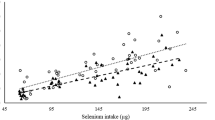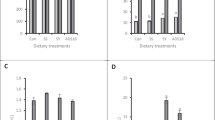Abstract
Experiments were conducted to determine whether the increased glutathione S-transferase (GSH-T) activity associated with selenium (Se) deficiency is necessarily related to losses in the activity of Se-dependent glutathione peroxidase (SeGSHpx) in chicks. Nutritional Se status was altered in two ways: by treatment with an antagonist of Se utilization, aurothioglucose (AuTG), and by feeding diets containing excess Se. Chicks given AuTG (10–30 mg AU/kg, sc) had growth rates and hepatic GSH concentrations that were comparable to those of saline-treated controls; however, their plasma GSH levels exceeded those of either Se-deficient (6-fold) or-adequate (3-fold) saline-treated chicks. Hepatic SeGSHpx activities of AuTG-treated chicks were hals those of controls under conditions of Se-adequacy; however, this effect was not detected when Se was deficient. Hepatic GSH-TCDNB (assayed with 1-chloro-2,4-dinitrobenzene) activities of AuTG-treated chicks were significantly greater than those of controls when Se was deficient (i.e., when SeGSHpx activity was 12% of the Se-adequate level); however, deprivation of Se did not affect GSH-TCDNB activity in the absence of AuTG. chicks fed excess Se (6–20 ppm as Na2SeO3) in diets containing either low (2 IU/kg) or adequate (100 IU/kg) VE, showed hepatic GSH-TCDNB activities and GSH concentrations greater than those of Se-adequate (0.2 ppm Se) chicks by 100% and 40%, respectively. That increased hepatic GSH-TCDNB activity can occur because of either AuTG or excess Se status under conditions wherein SeGSHpx activity is not affected indicates that the transferase response is not directly related to changes in the peroxidase.
Similar content being viewed by others
References
J. T. Rotruck, A. L. Pope, H. E. Ganther, A. B. Swanson, D. G. Hafeman, and W. H. Hoekstra,Science 179, 588 (1973).
K. E. Hill, R. F. Burk, and J. M. Lane,J. Nutr. 117, 99 (1987).
K. E. Hill and R. F. Burk,J. Biol. Chem. 257, 10668 (1982).
J. Prohaska and H. E. Ganther,Biochem. Biophys. Res. Commun. 76, 437 (1977).
R. A. Lawrence, L. K. Parkhill, and R. F. Burk,J. Nutr. 108, 981 (1978).
W. B. Jakoby, B. Ketterer, and B. Mannervik,Biochem. Pharmacol. 33, 2539 (1984).
A. Mehlert and A. T. Diplock,Biochem. J. 227, 823 (1985).
M. Chang, J. R. Burgess, R. W. Scholz, and C. C. Reddy,J. Biol. Chem. 265, 5418 (1990).
G. L. Xu and A. T. Diplock,Br. J. Nutr. 50, 437 (1983).
J. G. Bell, J. W. Adron, and C. B. Cowey,Br. J. Nutr. 56, 421 (1986).
Y. S. Kim and G. F. Combs, Jr.,Nutr. Res. (submitted) (1992).
J. Chaudiere and A. L. Tappel,J. Inorgan. Biochem. 20, 313 (1984).
M. A. Baker, C. J. Dillard, and A. Tappel,Drug Nutr. Interact. 3, 141 (1985).
S. D. Mercurio and G. F. Combs, Jr.,J. Nutr. 115, 1459 (1985).
C. J. Dillard, M. Hu, and A. L. Tappel,Chem. Biol. Interact. 64, 103 (1987).
R. A. le Boeuf and W. G. Hoekstra,J. Nutr. 113, 845 (1983).
J. N. Thompson and M. L. Scott,J. Nutr. 97, 335 (1969).
BAS (1983) Bioanalytical Systems, Inc.Oxidized and Reduced Glutathione. LCEC Application Note No. 55.
R. A. Lawrence and R. F. Burk,Biochem. Biophys. Res. Comm. 71, 952 (1976).
W. H. Habig, M. J. Pabst, and W. B. Jakoby,J. Biol. Chem. 249, 7130 (1974).
M. W. Whitacre, G. F. Combs, Jr., S. B. Combs, and R. S. Parker,J. Nutr. 117, 460 (1987).
O. E. Olson,J. Assoc. Offic. Anal. Chem. 52, 627 (1969).
G. F. Combs, Jr. and S. B. Combs,The Role of Selenium in Nutrition, Academic Press, New York (1986), pp. 310–312.
M. A. Baker, C. J. Dillard, and A. L. Tappel,Drug Nutr. Interact. 3, 141 (1985).
N. Tateishi, T. Higashi, S. Shinya, S. Naruse, and Y. Sakamoto,J. Biochem. 75, 93 (1974).
R. A. Le Boeuf, and W. G. Hoekstra,J. Nutr. 113, 845 (1983).
K. Yasumoto, K. Iwami, and M. Yoshida,Glutathione: Storage, Transport and Turnover in Mammals, Y. Sakamoto, et al., ed., Japan Sci. Soc. Press, Tokyo/ VNU Science Press, Utrecht, 1983, pp. 91–104.
B. Pehrson and S. Johnson,Zbl. Vet. Med. A 32, 492 (1985).
A. Chung and M. D. Maines,Biochem. Pharmacol. 30, 3217 (1981).
Author information
Authors and Affiliations
Rights and permissions
About this article
Cite this article
Kim, Y.S., Combs, G.F. Effects of aurothioglucose and dietary se on glutathione S-Transferase activities and glutathione concentrations in chick tissues. Biol Trace Elem Res 37, 165–177 (1993). https://doi.org/10.1007/BF02783792
Received:
Accepted:
Issue Date:
DOI: https://doi.org/10.1007/BF02783792




